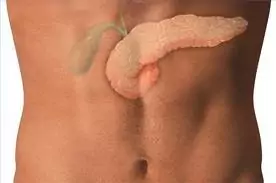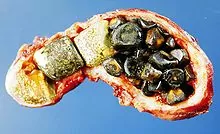35 Weeks Pregnant Baby Moves Feel Sharp Pain in Vagina
 Gallbladder problems including gallbladder attacks are very common reasons for which people seek medical care. The pain and discomfort can unfortunately result in the removal of the little green organ followed by dietary restrictions (often low fat). But of course, all of our organs are there for one reason or another and although we can live without the gallbladder, removing it is simply removing a symptom of a problem, not the actual cause. In this two-part article on the gallbladder I'll discuss why you have a gallbladder, why you should want to keep it (and keep it healthy), warning signs that your gallbladder isn't working well, risk factors, and natural treatments and lifestyle changes you can make to improve your gallbladder and overall health; yeah! If I can just save one more gallbladder I'll be a happy guy.
Gallbladder problems including gallbladder attacks are very common reasons for which people seek medical care. The pain and discomfort can unfortunately result in the removal of the little green organ followed by dietary restrictions (often low fat). But of course, all of our organs are there for one reason or another and although we can live without the gallbladder, removing it is simply removing a symptom of a problem, not the actual cause. In this two-part article on the gallbladder I'll discuss why you have a gallbladder, why you should want to keep it (and keep it healthy), warning signs that your gallbladder isn't working well, risk factors, and natural treatments and lifestyle changes you can make to improve your gallbladder and overall health; yeah! If I can just save one more gallbladder I'll be a happy guy.
Gallbladder Physiology: Bile is so Good for You
Let's take a brief lesson in gallbladder physiology here, and I'll make it interesting and relevant to your everyday health. The gallbladder is a small organ that sits tucked up underneath the liver in the upper right side of your abdomen. It concentrates and stores bile produced by the liver, and along with the enzyme lipase secreted by the pancreas, it aids in the digestion of fats in the gut. When fats from food enter the digestive tract they stimulate the secretion of a type of hormone called cholecystokinin (CCK) in the upper part of the small intestine – the duodenum. This, along with the stomach's secretion of hydrochloric acid, signals the gallbladder to release some of its approximately 50mL of bile into the gut to help aid in digestion of those fats. Since by most, it's viewed as a "storage tank" and nothing more, it's often seen as only a nuisance when it comes to digestive problems and pain – expendable at the first sight of problems and removable with surgical ease. But there's so much more to it than just storage.
Bile is a lovely dark green/yellow-brown fluid and contains about 10% bile salts. The bile acids (salts) have a strong relationship to hormonal regulation as they share many of the same synthesis pathways as hormones. This is why people with hormonal problems, especially women with estrogen dominance, are more susceptible to gallbladder problems. The more hormonal stress on the body the lower the bile acids which in turn disrupts normal hormonal metabolism. It's not a coincidence that many women have their gallbladder removed at the same time they have a hysterectomy.
Speaking of hormones, just a few years ago it was demonstrated that the gallbladder also plays a role in insulin regulation and that β-like cells that produce insulin in the pancreas also occur in the gallbladder. Insulin is also metabolized by the liver and can therefore have an effect on the bile salts – so diets high in refined carbohydrates and those with insulin resistance will also be more likely to have troubles with their gallbladder.
Bile also increases the absorption of fats and especially the fat soluble vitamins A, D, E, and K. We all know the push for vitamin D by every doctor and health food store today. Consider that if you have an unhealthy gallbladder then your absorption of vitamin D, as well as the other fat soluble vitamins necessary for good health, will also be impaired. So just because your vitamin D level may be low as revealed by a blood test, doesn't mean you should go vitamin D supplement-crazy; that's not necessarily addressing the problem.
Bile and Cholesterol
A small percentage of bile is cholesterol but the majority of bile acid is made from cholesterol; actually about half of the cholesterol our body makes per day is used to make bile acid. These bile acids are recycled from the intestines and back to the liver and gallbladder. However if there are problems with digestion, such as an all-too-common poor diet, then the salts can become "dirty" – the bile becomes thick like a vehicle's oil that is way past the oil change date.

Eventually this thick, dirty bile can accumulate and form a gallstone, also known as a cholelithiasis. Usually these stones contain some or a significant amount of cholesterol, so it's often cholesterol that gets blamed for causing the stones when really it's an issue with oxidative stress, inflammation, and digestive problems caused by other factors, (discussed in a bit). Gallstones in the gallbladder can lead to cholecystitis, which is an inflammatory condition of the gallbladder. The stones leaving the gallbladder can also obstruct the bile ducts which can be life threatening, especially if a stone blocks the pancreatic duct leading to pancreatitis.
Also, low levels of bile salts can be a reason for gallstones; this problem would ultimately fall on a production problem with the liver.
Should You Remove Your Gallbladder – You Don't Need it Anyway (?)
The surgical removal of the gallbladder is called a cholecystectomy. This is a common procedure that with rare exception, is unnecessary and does not address the problem. Some people who have had their gallbladder removed will see absolutely no change in their symptoms while others may have their symptoms 100% resolved. Others who have had a cholecystectomy may no longer be able to eat high fat foods as their body is unable to handle too much fat digestion at once due to the removal of their bile storage tank. However, the body in its infinite wisdom can often form a new little storage pouch in the area of the common bile duct to store some bile for when it's needed.
So how do you know if your gallbladder is at the point of becoming a life threatening emergency or you're simply experiencing gallbladder troubles that perhaps can be dealt with in a non-surgical manner? Well, without giving specific medical advice for every situation, a good rule is to look at the severity of the signs and symptoms. Someone who is having a gallstone attack typically has pain in the upper right side of the abdomen and/or pain in-between the shoulder blades, more often below the right shoulder. It's uncomfortable and can get to the point of being very painful. Sometimes nausea and vomiting can occur which can last for minutes to hours. Now if the pain and vomiting get worse and worse then you should of course seek medical attention. (Gallbladder attacks and heart attacks can have very similar symptoms – heart attacks don't always have pain down the left arm only.) Typically gallbladder attacks don't just come out of nowhere where the person never had any symptoms of a gallbladder problem and now all of a sudden they have a huge stone lodged in their bile duct. So you have to know the symptoms of poor gallbladder function so you can address the issue before it gets too out of hand.

When Your Gallbladder Isn't Working Too Well – Gallbladder Referred Pain – Signs & Symptoms
There are many signs and symptoms of a gallbladder that isn't functioning very well and most people just think they're common "normal" symptoms so they think nothing more of it. Then, "all of a sudden" they get a major gallbladder attack and are puzzled as to how it could have happened to them. Well, I'm hopefully going to keep you from being surprised!
- Constipation, actually gallbladder constipation. Yes, a major reason for constipation is a poorly functioning gallbladder. When fat enters the small intestine it has to be metabolized by those bile salts and the lipase from the pancreas; (you learned this already, right?). But if the bile isn't released efficiently from the gallbladder then the food and its fatty contents must wait longer and longer in the small intestine to be metabolized. So they wait. And wait. And wait. And you get constipated. So don't necessarily think that you need more fiber, or you need probiotics if you're constipated – consider your gallbladder.
- Aside from constipation and the gallbladder referred pain areas discussed (upper right abdomen and right shoulder area), another symptom of an unhappy gallbladder is burping after or while eating a meal – especially one containing fat. Typically this person will also feel "heavy" and even perhaps bloated if they're having problems digesting a fatty meal because their gallbladder isn't doing its job. Burping can be from eating too quickly too but burping from a gallbladder problem usually accompanies heaviness.
- Another symptom of a gallbladder issue is peeling of the skin on the palms of the hands and the soles of the feet. This is due to an inefficient fat metabolism system as well as metabolism problems with vitamin A (fat soluble). I've seen patients present with some pretty wild looking palm and sole peeling that nobody was ever able to understand why. This too, is often a gallbladder problem.
-
 Finally, and I discuss this in my articles on sleep, the horary time (acupuncture meridian) for the gallbladder is 11pm to 1am. So if you can't fall asleep until after 1am or if you're asleep before 11pm but then awaken between 11pm-1am it could very well mean your gallbladder is stressed. Also note that liver is next, from 1-3am, and this is the most common time a person has sleep difficulties for many, many reasons – caffeine, hormones, stress, medications – just to name a few, and all these can also affect the gallbladder too as well as bile production in the liver.
Finally, and I discuss this in my articles on sleep, the horary time (acupuncture meridian) for the gallbladder is 11pm to 1am. So if you can't fall asleep until after 1am or if you're asleep before 11pm but then awaken between 11pm-1am it could very well mean your gallbladder is stressed. Also note that liver is next, from 1-3am, and this is the most common time a person has sleep difficulties for many, many reasons – caffeine, hormones, stress, medications – just to name a few, and all these can also affect the gallbladder too as well as bile production in the liver.
In Part II of Gallbladder Health I'll discuss how to prevent problems with your gallbladder as well as natural treatments for optimum function of your gallbladder PLUS emergency help to calm down or resolve a gallbladder crisis.
35 Weeks Pregnant Baby Moves Feel Sharp Pain in Vagina
Source: https://drgangemi.com/health-articles/digestive-health/gallbladder-referred-pain-constipation/
0 Response to "35 Weeks Pregnant Baby Moves Feel Sharp Pain in Vagina"
Postar um comentário